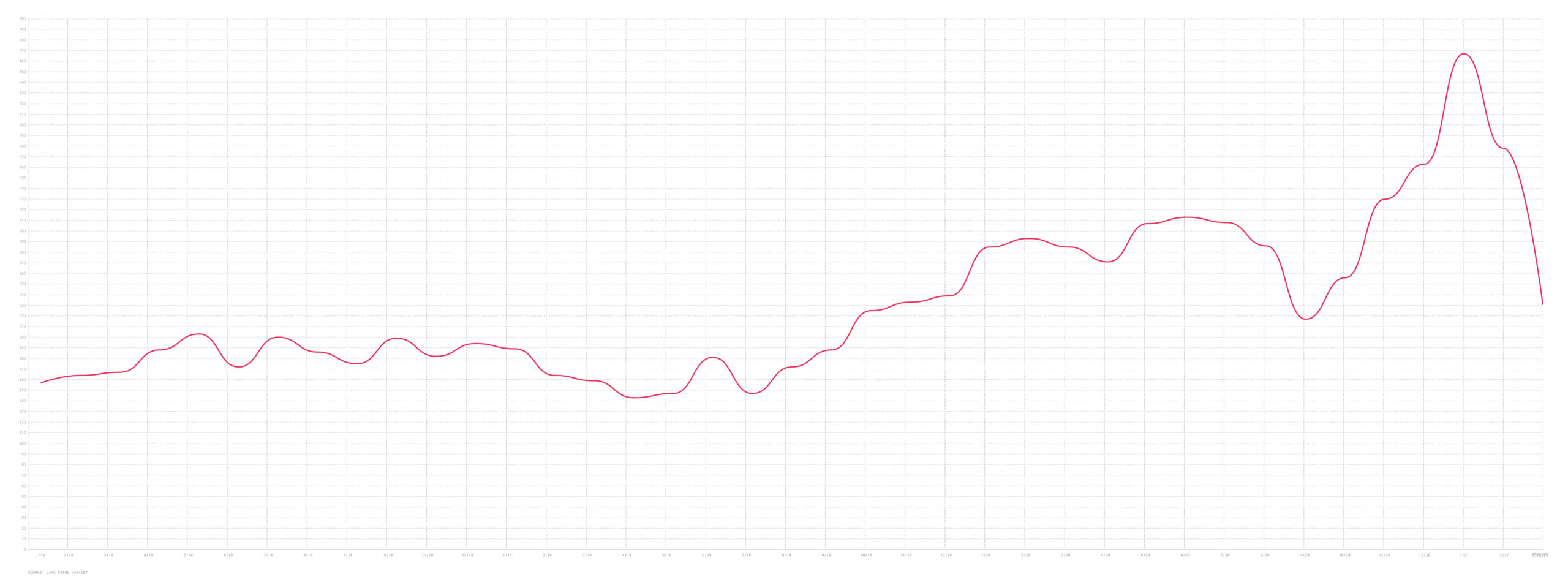Scrap that: your catalytic converter got stolen

Los Angeles is suddenly dealing with a second epidemic: a flurry in thefts of catalytic converters ripped from the underbellies of cars.
On March 10, sheriff’s deputies in Santa Clarita recovered 250 converters valued at $750,000. That same day, officers from the Santa Monica Police Department arrested three suspects who were caught in the act of stealing a catalytic converter. In Cerritos, the Los Angeles Sheriff’s Department is putting on a workshop about how to keep converter thieves at bay.
And in January, the city of Los Angeles hit a record, recording the highest number by far of auto-parts thefts in at least 11 years, at 471.
Auto-part thefts in Los Angeles, January 2018-March 15, 2021

Unlike other car parts, which are often sent to chop shops, catalytic converters are targeted for their precious metals, which include platinum, palladium and rhodium. Because of their value, thieves can resell stolen converters at scrap yards for up to $200 each. Catalytic converters are responsible for regulating a vehicle’s exhaust emissions. Thieves remove the device from under the vehicle with power tools. When owners turn on their car’s engine, they hear a loud rumbling noise, indicating that their converter is missing.
The rise in catalytic thefts is not confined to Los Angeles. Even London has seen a rise in catalytic converter thefts. On the morning of March 23, the Metropolitan Police issued 30 warrants for East London residential properties and seized a storage container filled with stolen converters that was headed for the Ivory Coast.
In Los Angeles, reports of stolen car parts started to rise in August of 2019. But they began to skyrocket in October of last year, when there were 256, and they almost doubled from that amount three months later. The months between November 2020 and February represent the four highest monthly totals for auto-part theft reports recorded in the city since 2010, when the Los Angeles Police Department began to make its data public.
Morgan Godvin has been hit by converter thieves twice. Godvin, who lives in Los Angeles part time, first had her converter stolen in Portland, Ore., on Jan. 6. Two weeks later, she was parked on Rose Avenue in Venice when someone attempted to saw off her replacement converter, but didn’t actually succeed.
“They said that the thief probably didn’t take it because it wasn’t worth stealing,” said Godvin. “It was a $100 junk part off Amazon that was illegal to be driving in California. And that is what the shop in Portland had put in my car and billed my insurance $1,600 for.”
In the end, with the cost of her deductible, a protective catalytic converter shield and rental car fees, Godvin paid about $800. Without a comprehensive insurance plan, Godvin said she would have had to pay about $3,000 for the repairs.
It’s unclear what is driving the current spike in converter thefts. However, in periods of economic downturn, thefts of items from manhole covers to copper cables for trains often rise. But the financial burden on victims is great: It can cost upwards of $2,000 to replace a converter.
Los Angeles Sheriff’s Deputy Welby Cham, who works out of the Cerritos station believes that the recent increase in thefts can be attributed to shortages in the precious metals as more electric cars are hitting the streets. He said 80 vehicles are currently booked to have their converters etched at the station’s April 7 event. Cham is hopeful that the station will be able to open up more reservations for Cerritos residents at future converter etching events.
While all car owners should be vigilant, the Los Angeles Sheriff’s Department warned that thieves tend to target models such as the Honda Accord, Toyota Prius and Ford Excursion. In order to protect vehicles from converter theft, the department recommends that people park their cars in well-lit areas or inside garages, and to weld the converter’s bolts or install a cage around the device.
How we did it: We examined publicly available LAPD data on reported crimes in the city of Los Angeles, and reported crimes from the Los Angeles Sheriff’s Department. LAPD data only reflects crimes that are reported to the department, not how many crimes actually occurred. In making our calculations, we rely on the data the LAPD makes publicly available.
The LAPD periodically updates past crime reports with new information, leading the department to recategorize past reports. Additionally, revised reports do not always automatically become part of the public database.
Want to know how your neighborhood fares? Or simply just interested in our data? Email us at askus@xtown.la.






